Family : Pinaceae

Text © Eugenio Zanotti

English translation by Mario Beltramini
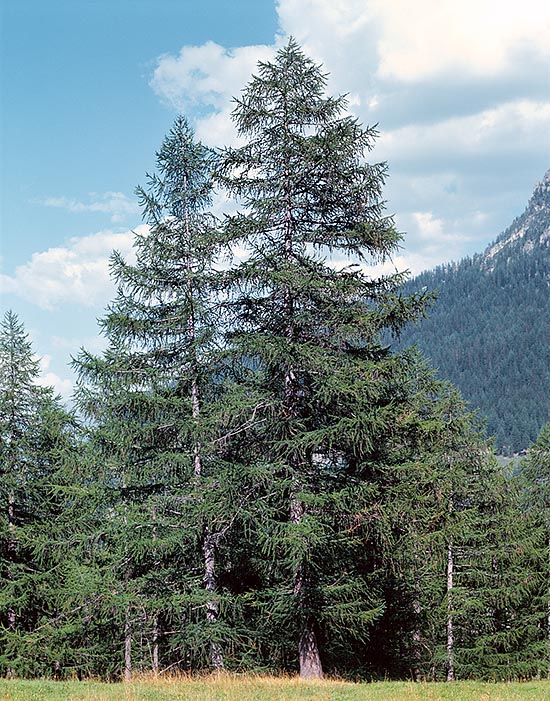
Larix decidua reaches 50 m of height, with diameter of 1,5 et the base, and grows up 2400- 2600 m of altitude. It’s a pioneer species, with fast growth when young © Giuseppe Mazza
The name of the genus Lárix finds assonance with the Greek term “larika”, pleasant smell, gentle, for the balsamic smell of the resin of this species; after others it should come from the Celtic “lar”, fat, rich, abundant, probably due to the huge quantity of resin emitted by the trunk; after Dioscorides, “larix” is the Gaulish name of the resins.
The name of the species decidua, from the Latin “deciduus”, indicates that this is a deciduous species. Alpine tree par excellence “Not only because it has a typically alpine distribution, but because it is present in the most luminous and rocky locations and landscapes, advancing even in daring isolation stony grounds, in the steep slopes beyond the limit of the most elevated forests”. (V. Giacomini). In the Alps is surpassed in abundance only by the European spruce (Picea abies).
The genus Larix includes ten species (after some authors, 12) diffused in the cold regions of the boreal hemisphere; Larix sibirica, along with the European spruce, forms in northern Russia and in Siberia very great boreal forests which surpass, as dimensions, the Amazon rainforest. Larix decidua has an orophyte central European range.
The Larch or European larch (Larix decidua – Miller 1768) is a tree of the first magnitude, elegant and majestic that can reach many centuries of life (from more than 600 years up to 2200!), with a slender trunk that can reach 45-50 metres of height even if, as an average, it stands on 15-25 m, and 1,5 m of diameter at the base: at times slightly curved close to the collar.
Larix is the only genus of European conifers including deciduous species (which lose their leaves in winter).
When young, it has quite a fast growth; when adult the stem has a very thick bark (which absorbs the shocks of the rocks often detaching from the slopes), grey-brown, which peels in reddish plates, with grooves of 1,5 cm maximum; irregularly verticillate, horizontal or drooping and light crown, pyramidal in the young specimens in the woods, enlarged at the base in the oldest and isolated trees.
It develops a strong radical system formed by a robust central taproot and by long and deep oblique roots which allow it to reach the water in the lower and more protected layers of the soil, dominating, unchallenged, the highest forestall regions.
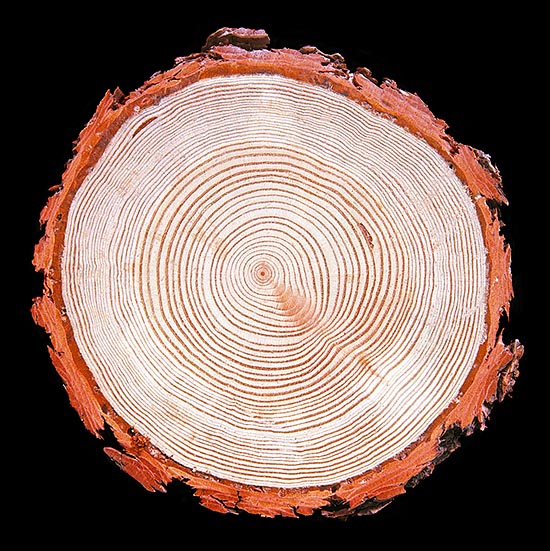
Count the rings. This is a young plant, but a larch can live even 2200 years. The wood is much praised due to the remarkable resistance to the atmospheric agents and the woodworms © Giuseppe Mazza
One year old pendulous small branches, longitudinally striped, with bluish efflorescence and sparse pubescence, then reddish brown, glabrous and bright. Brachiblasts (very short branches with very reduced distances between the nodes), slightly cylindrical (3 x 5 mm) with bunches of 30-40 pale green leaves, capillary, tender, of 1 x 8-18 mm, with triangular section, with two greenish lower stomatal lines. Other sparse needle leaves are carried on the young, elongated, branches.
The reproduction takes place from April to June.
The male amenta are globose, very small, yellowish, bent downward; the female ones (2-3 cm) are very showy, erect, with red-purplish scales (grey-brown after the fecundation) ripening during the year (November-December) but the seeds are not freed by the scales until the following March.
The seeds are brown-glossy, angular (3-5 mm), with membranous wing, semi-ovate, of about one cm; they keep well up to three years and for the propagation they must be entrusted to a loose, sandy, soil. The seedlings are born after 6-8 weeks and must be sheltered up to their fourth year from the sun and the strong winds.
The seeds of the larch are food for granivorous birds such as the common crossbills (Loxia curvirostra), a passeriform with the crossed bill suitable for opening the cones of the conifers.
Species greedy for light, pioneer, living in mountain and sub-alpine woods, the sunny pastures, the dry slopes, the screes, up to the limit of the trees, from the plain (like in Poland and in Central and Oriental Alps) up to 2400 (2600) m of altitude on every substratum but the clayey one. At higher altitudes it associates with the alpine shrubs, with the Swiss pine and the spruce, at the intermediate altitudes cohabits with the spruce, the Scots pine and the birch, whilst at the altitudes of the mountain plan associates with the beech, the common hornbeam, the common hazel and other broad-leaved trees.
Larix kaempferi, native to Japan, often cultivated for reforestations especially in southern Italy, has young glaucous sprouts and more than 40 needle leaves, these ones with two white lines (stomata of the lower side) and scales of the cones bent outwards.
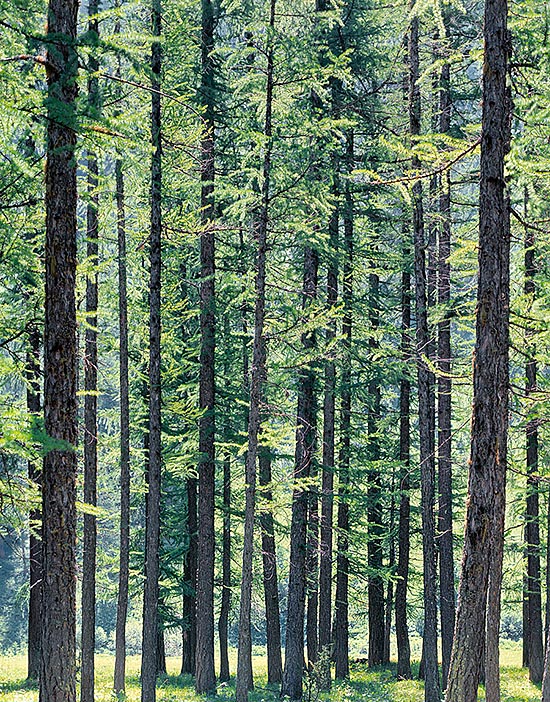
Is often cultivated for reforestations, or for production of wood and of turpentine © G. Mazza
Also exists the hybrid between Larix decidua and Larix kaempferi (= Larix x eurolepis) planted for the timber.
The fossilized findings have proved that the larch was already diffused in all the alpine region since the Pliocene, last phase of the Tertiary, more than one million of years ago.
The wood of the larch is very much appreciated because hard, compact, semi-heavy, resinous, with whitish or yellowish alburnum and yellow-tawny to brown-reddish duramen, with well visible and sinuous growth rings, endowed of remarkable resistance to the atmospheric agents (hoses with larch shutters more than 200 years old are still in good condition!), to the humidity and to the woodworm.
With it are made furniture and external structures of houses; in the past it was largely used for building naval casings, doors and windows, floors and telegraph poles.
Since the ancient times, the 60 metres long beams carried to Rome by order of Tiberius, aroused wonder and curiosity among the population, from the smaller trunks they made pipes for water transportation.
The city of Venice was founded on beams of larch and of black alder because of their imputrescibility and duration in the water.
Not less, in the Canton of Valais was described a house of countrymen built in larch existing for over than 240 years and its wood was still sound and whole so much that it was almost impossible to penetrate it with the tip of a knife!
The beams and planks of larch, positioned on top of each other, under the action of the sun release the resin which flows and unites the interstices and in such way the houses become impenetrable to air and humidity.
It is not, however, a prized fuel as it burns quickly doing a lot of smoke (because of the resins it contains) and is consumed rapidly.
From the larch the shepherds get the material for building their shelters, it furnishes the fuel for the fire in the huts, gives shelter from the sun to the animals at the summer pasture, hampers the slippage of snowslides on step slopes, retains and reinforces the soil with its strong roots.
The famous forester Giovanni Sala, author of an important monography about the larch, did write (1937) :
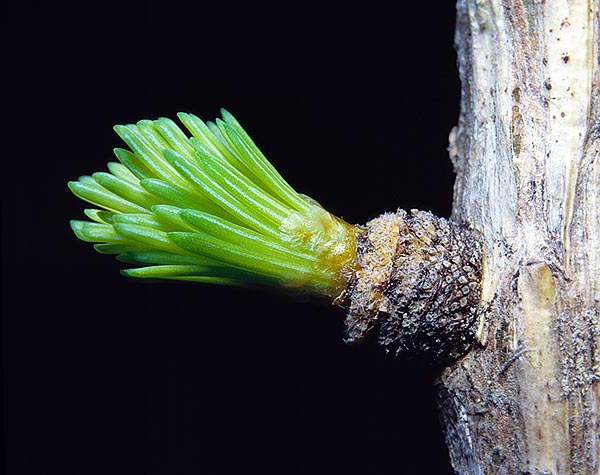
Opening gemma, after winter rest, with 30-40 leaves bunch. Rich in vitamin C © Giuseppe Mazza
“Up there in the Alps, at the limits of the arboreal vegetation, the larch seems to have an eternal life. Though tormented by the cattle, mistreated by the storm and by the tempests, continues to grow, to resist, clinging firmly to the ground with the roots often inserted into the crevices of the alive rock, and also when one only broken branch forms its crown, thus reduced to a semi-dried stump, it does not die”.
From the point of view of the adversities, the most important parasite is the well known Lachnellula (alt.Dasyscyphus) wilkommii, fungus agent pathogenous of the larch canker that causes major hollow deformations on the trunk.
The fungus Ascocalix laricina causes damages to the young buds, whilst other species belonging to the genera Armillaria, Polyporus and Rhizina are cariogenic, and the so-called Rust of the larch (Melampsora larici-populina) affects the needle leaves.
Some insects, like Coleophora varicella and Taeniothrips laricivorus cause the fall of the needles.
The resin of the larch, obtained by means of incisions in the bark or holes in the trunk done from spring to autumn, is known as Venice turpentine (Terebinthina veneta F.U.I.). It is a dense liquid, non-crystallizable, of yellowish or greenish-yellow colour tending to turn yellow-brown, slightly fluorescent, and transparent, of persistent balsamic odour and of bitter, acrid and aromatic taste. The operation of extraction from the larch is clearly different from the other systems of getting the resin usually utilized for the other conifers producing resins; whilst for these last are made superficial incisions interesting only the bark, for the larch is adopted, in spring, the deep perforation and this because the resiniferous channels are not localized only in the bark, but are distributed in all the section of the wood. The hole, of a diameter of 2,5-4 cm, is immediately plugged with plugs gotten from twigs of larch; the collection is done unplugging the holes in mid-summer and in autumn and plugging them again when the operation is concluded.
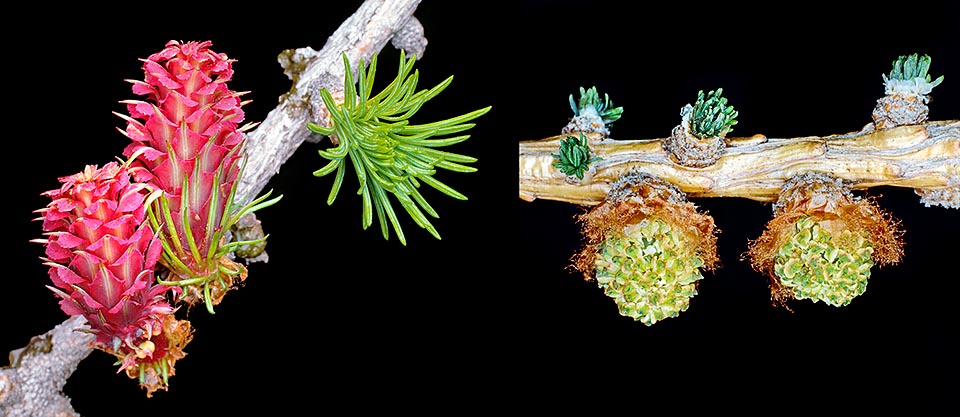
Larch marriage occurs April to June. The male amenta, here to the right side, are globous, very small and yellowish, looking down, whilst the female ones, <br />by sure showier on the left side, are erect. They can reach 2-3 cm of lenth with red-purple scales turning grey-brown after the fecundation © Giuseppe Mazza
by sure showier on the left side, are erect. They can reach 2-3 cm of lenth with red-purple scales turning grey-brown after the fecundation © Giuseppe Mazza
In the past, the Venice turpentine was used in the industry for the production of colours, varnishes, lacquers, protective ant-salt and ant-rust layers, with other ingredients in the production of special inks, grafting waxes, adhesives, etc.
Through distillation we get, in the proportion of 1:4, the essence of turpentine (or terebinthine); this contains an essential oil, laricinic acid, resins, gum, tannic acid, alpha-pinene, delta-3-carene, beta-pinene, beta-pyrone, the polysaccharide arabinoglactan (that has proved useful as probiotic and as modulator of the immune system); the solid part remaining after the distillation is known as colophony or Greek pitch. The essence is employed especially in the diseases of the respiratory system and has antiseptic and astringent properties, as well as in the cases of poisoning by phosphorus.
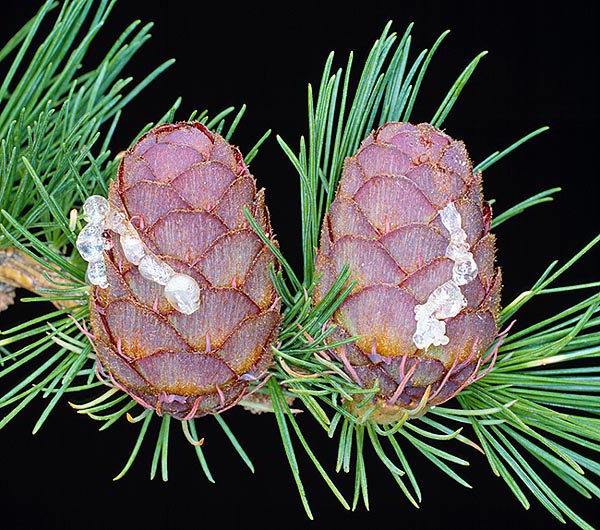
The cones ripe at year end, but the seeds, protected by the resinous scales, are freed only the following March. From the resin, which has various medicinal properties, they get the turpentine © Giuseppe Mazza
For external use are made ointments mixing in equal parts turpentine and white vaseline for stimulating the natural defences in case of infections tending to extend.
The leaves (rich inter alia of vitamin C) and the gemmae are used in the rheumatic and arthritic ailments.
If you visit the high mountain in autumn, do not forget to take off a handful of the resin which exudes from the bark of the larches, you can conserve it sheltered from the light in a glass pot and use, twice a day, a teaspoon of it in a container with boiling water for healthy fumigations to favour the expectoration in case of dry cough, for decongesting and purifying the airways.
In summer, the needle leaves of the larches, due to the action of a migratory bee (Apis laricis) exude a sugary substance that in the morning coagulates in white and viscous granules containing the trisaccharide melizitose, known also as Briançon manna that above bees transform in an excellent honey, with mild laxative properties like that obtained from the manna ash.
In late autumn the light green of the needle leaves of the larches turn a splendid golden yellow, and, falling, cover the ground with a soft carpet covering all the asperities of the rocky terrain conferring the habitat an indescribable charm.
The larch woods are luminous, usually sparse, the oldest specimens cover of the grey-green drapes of the Usnea barbata, a lichen known also as “larch beard” or “beard moss” giving the wood a note of fairy mystery.
We end with the nice words dedicated to the Alpine woods by Valerio Giacomini taken from the precious small book “Italia verde” (1975) where are described the landscapes of the Bel Paese:
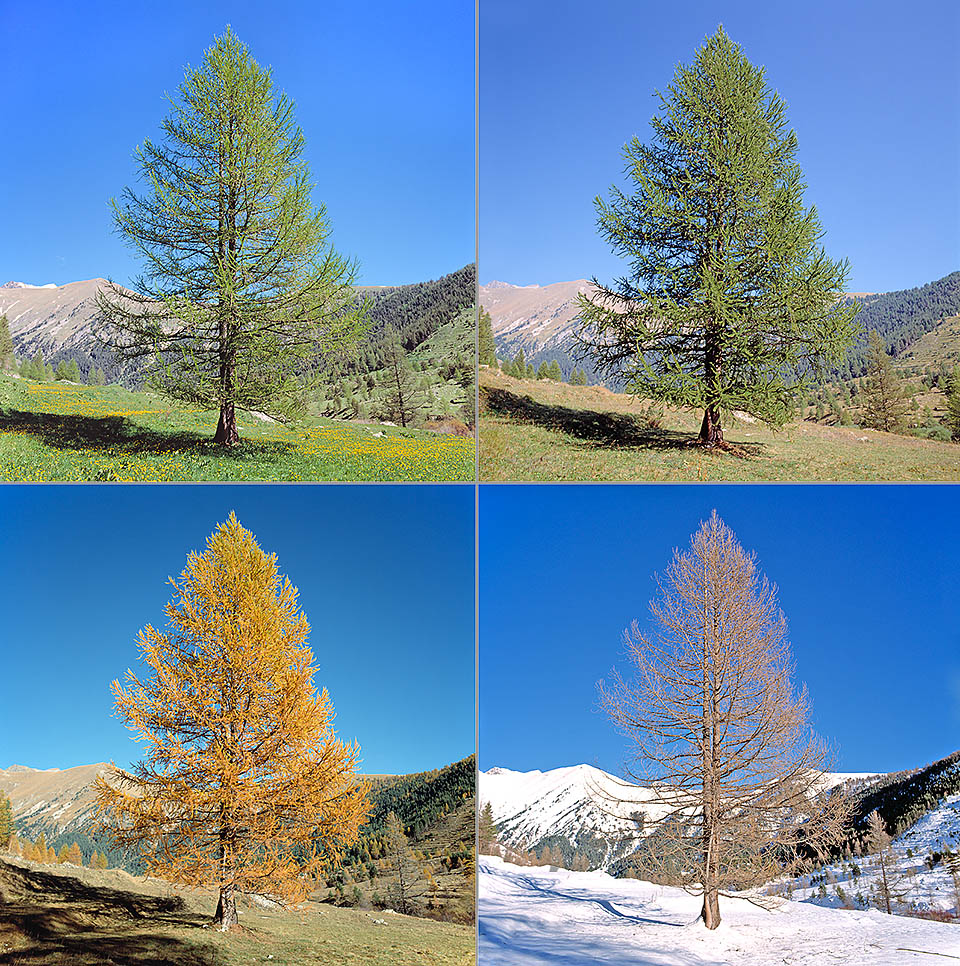
An isolated larch, in altitude, snapped in the four seasons. The genus Larix is the only, among the European conifers, loosing the leaves in winter. In autumn it creates magnificent golden views and the light, however filtered through the branches all the year, allows various vegetal associations colonizing stony grounds and lands at the limit of the eternal snow © Giuseppe Mazza
“ The temperate solemnity of the alpine forests fits into landscapes of unequalled grandiosity, created by the magnificence of the granitic and dolomitic mountains, by the splendour of the eternal snows and glaciers, by the emerald basins of the lakes, by the gentle expanses of grassland. Extraordinary and contrasting harmonies establish between the sky, the land and the waters especially where they advance towards the highest rocks, and towards altitude prairies, the last troops of this bravely constructive vegetation, which defies the frosts and the lightnings”.
Synonyms: Pinus larix L. (1753); Pinus larix var. europaea Pall. (1784); Larix europaea DC. (1805); Abies larix Poir. (1805); Peuce larix (L.) Rich. (1810); Larix gracilis A.Dietr. (1824); Larix excelsa Link (1827); Pinus larix var. pendula (P.Lawson) Endl. (1847); Abies larix var. pendula (P.Lawson) Lindl. & Gordon (1850); Larix decidua var. rossica Henk.& W.Hochst. (1865); Larix decidua var. russica (Endl.) Henkel & W. Hochst. (1865); Larix decidua var. pendula (P. Lawson) Henkel & W. Hochst. (1865); Larix europaea var. pendulina Regel (1870); Larix europaea var. pendulina Regel (1870); Larix decidua var. pendulina (Regel) Regel (1871); Larix decidua var. sibirica (Ledeb.) Regel (1871); Larix decidua fo. pendula (P. Lawson) R.E.Fr. (1919); Larix decidua Mill. var. carpatica Domin (1930); Larix decidua var. polonica (Racib. ex Wóycicki) Ostenf. & Syrach (1931); Larix sudetica Domin (1930); Larix decidua subsp. europaea (DC.) Domin (1931); Larix decidua subsp. sibirica (Ledeb.) Domin 1931; Larix decidua subsp. sudetica (Domin) Domin (1931); Larix decidua subsp. polonica (Racib.) A.E. Murray (1982); Larix decidua Mill. subsp. carpatica (Domin) Silba (2008).
→ To appreciate the biodiversity within the PINACEAE family please click here.
